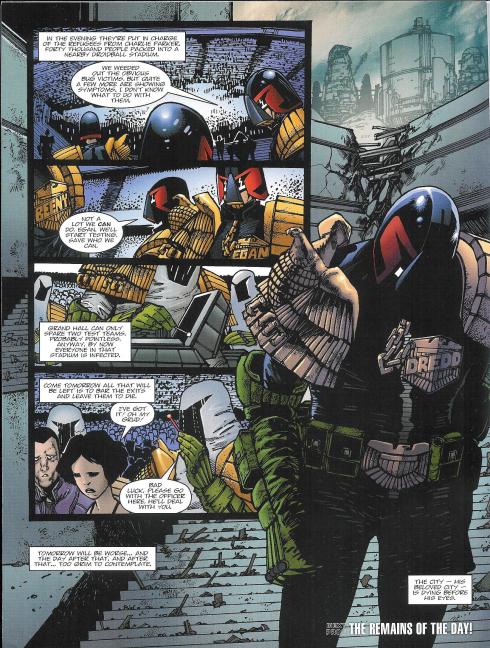Futurshockd took the year off this year. Sorry. Well, it was nice out. However in our absence the world seemed to take distinctly more notice of 2000AD with both the Dredd 3D movie (hurrah!), IDW’s Judge Dredd (hummmm) and increased coverage on major comics sites (much love and respect to Forbidden Planet’s Prog Pledge for the weekly effort). However Futureshockd is ready to return to the enjoyable task of whipping though the decades of 2000AD’s short stories so its fitting to return where we left off, with a review of what has happened in the last years Prog and Meg. As with a calendar year ago the time is ripe to jump on the Prog as Prog 2013, in shops over the New Year, contains the jump-on point for the next 5 tales which will doubtless take readers trough till the end of February. And for new subscribers the second volume of Tharg’s Futureshocks ‘B / Manga format’ Collections is your exclusive reward for subscribing to the House of Tharg’s hard-copy. This collection is a particular joy for fans of Belardinelli with no fewer than 10 strips illustrated by the departed weirdsmith.

Future Shocks Subscribers Exclusive Vol.2
Cover by Grant Perkins and Jamie Roberts
The stories in this exclusive collection are plucked from various Progs published between 1987 and 1989 (prog 539 – 648) and features such writers as Mark Millar, John Smith, Jim Campbell and future-Tharg Alan Mackenzie. As well as Belardinelli the art duties include such luminaries as Glenn Fabry, Mike Collins, Will Simpson, Richard Elson, Kev Walker, Jose Ortiz, Paul Marshall and the classic Dredd artist Ron Smith.
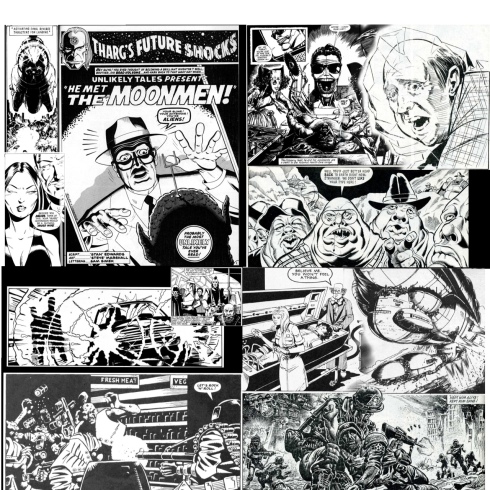
Art from Futureshocks Subscribers Exclusive Vol.2 – (clockwise from top right) by Will Simpson, Paul Marshall, Glenn Fabry, Mick Austin, Ron Smith, Kev Walker, Chris Weston, Massimo Belardinelli, Nigel Dobbyn, Richard Elson, Massimo Belardinelli, Mark Farmer
Tharg’s droids have made a fine selection from the time and the collection marks how Futureshocks were being used to test new talent rather than being given to old professionals. Indeed only Jose Ortiz and Belardinelli feature from the group who handled duties on the first 200 progs. Names such as Weston, Fabry, Marshall and Elson would all go on to have successful spells on strips such as Dredd, Slaine, Kingdom and Indigo Prime as well as successful careers in US comics. As for the Shocks themselves, well reviews of those will have to wait till the blog gets to them but there are many quality thrills, several of which will ping instantly back to the minds of former readers. Sadly the large Belardinelli count does not find room to include the magnificent Smith / Belardinelli ‘One Man’s Meat‘ from Prog 563, surely the finest strip to ever feature a cute alien-hippo with a gun to its head. For this delight from the Era check the still available Best of Future Shocks.
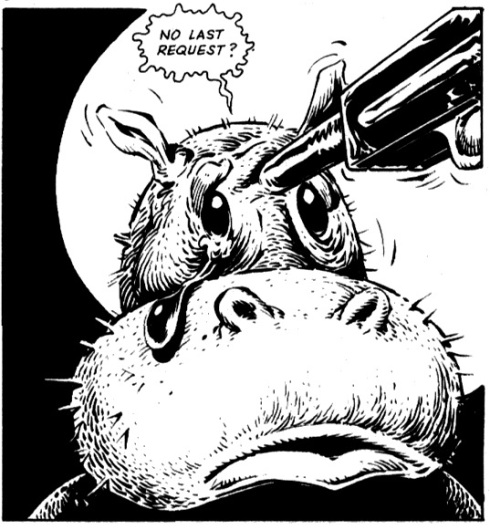
One Man’s Meat – Prog 563 – Art Massimo Belardinelli
Wisely avoiding overlapping the Best of Future Shocks can be seen to have taken a few of the better tales from the Era out of consideration but that doesn’t mean there aren’t gems aplenty in the subscribers exclusive and the art work, especially from Weston, Belardinelli, Smith and Marshall is top notch. Fans of Golden Era comics will especially appreciate the formalism and style jokes in He Met the Moonmen, a strip which demonstrates Paul Marshall’s neat flare for aping past stylisms that would also feature so effectively in Prog 2010’s festive Dredd tale O’ Little Town of Bethlehem. Future Shocks Vol. 2 is, like its predecessor volume, a great reason to make the move to a full subscription with the House of Tharg.
Of course the primary reason to subscribe to 2000AD is the content of the weekly Prog and Monthly Meg and the proof of value is best illustrated by looking back on ‘what you would have won’ had you taken the plunge last year. Subscribers hauled in 50 editions of the Prog:

13 Issues of the Judge Dredd Megazine:

and 13 reprint Graphic Novel ‘floppies’:

As with last year, a sub buys you just over 1800 pages of new comics, and an additional 700 plus pages of reprints, as well as interviews, star scans, the odd gift (this year Chris Weston’s magnificent multi-cast cover as poster) and advanced delivery a few days before it hits the shelves in town. Be the envy of squaxx everywhere by spoilering Dredd for them on a Monday morning.
However pretty covers and page count don’t make up for content (hiya Clint readers!) so what was contained in 2000AD in the last year? As with the 2011 review we’ll pick a top ten list of moments in Dredd and a slightly expanded top 12 of non-Dredd stories. Feel free to quibble over the choices and let Futureshockd know what you’ve have had in the lists instead! For those that take exception to our selections there is plenty of pretty artwork for you to enjoy instead.
The Year In Dredd
Dredd in 2012 was dominated by two towering achievements – the first half of the year saw John Wagner’s Day of Chaos leave readers reeling while the months of November and December brought Dredd, The Simping Detective and Lowlife into an astounding cross-over that left everyone applauding just how darn clever it was. Very few strips managed to deal with the post-Day of Chaos expressly. Robbie Morrison’s Innocent contained some flashbacks and Michael Carroll’s Debris made best use of the ‘new’ city so far but still there was very much a feeling of writers not yet having got around to Wagner’s new rules. Given the length and impact of the stories that book-ended the year a great many other shorts can’t make it into a ‘best of’ but there was a great deal of good stuff outside of this list. Mark Harrison produced fantastic art in a rare strip appearance for Asleep (Prog 1804-05), Michael Carroll grabbed former exile Judge Doleman and returned him to assist in the clean-up (Debris, Prog 1792-1796) while Alan Grant took Ratfink out of his cell for a run-around before returning him for safekeeping (Ratfink’s Revenge: Meg 328-330). Gordon Rennie and Paul Marshall’s Killer Elite (Meg 328-331) only narrowly missed out on the list and ensured the Meg ended in rude health with a great tale of humour, revenge, stonewalling Dredd and a high body-count. Whether it also marked the end of Rennie’s ‘Global Psycho’ stories will be intriguing to see.
10) Prog 1786 – Wot I Did During the Worst Dissaster in Mega City History: Script: John Wagner, Art: Henry Flint
Right on the cusp of the ‘actual’ Day of Chaos John Wagner throws a curve-ball at the fan-base who had speculated that arch-foe PJ Maybe, elaborately escaped from prison during the prologue to the epic, would play a significant role in its conclusion. However Wager punts Maybe and the long-absent Dark Judges into the long grass via a comedy 6 pager where Maybe outfoxes the slightly naive Fear Fire and Mortis and goes back to stealthy wealthy domesticity. Wot I did, blessed with the ever excellent Henry Flint on art duties, was a fun change of pace and showed that while Dredd’s world may be going to Hell, PJ’s wealth and cunning allowed him to, yet again, be relatively unfazed by the fate of Mega City One.
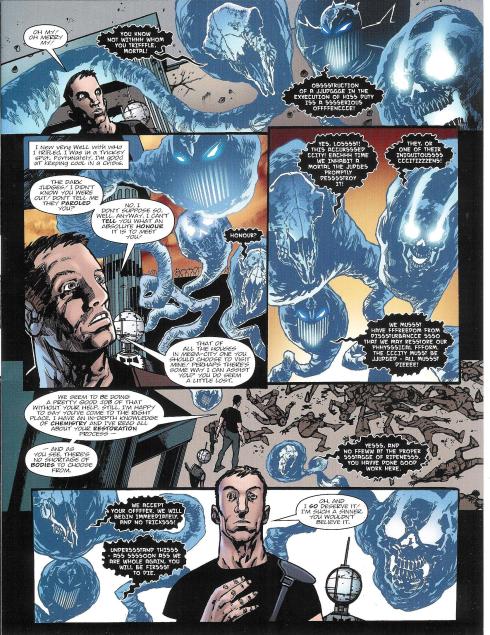
9) Meg 328 – Top of the World, Ma-Ma: Script Matt Smith, Art Henry Flint
2012’s investment into Dredd saw different versions of the character emerging, both IDW’s take and this movie-prologue which appeared online and in the Megazine. Written by Tharg’s earthly ambassador, Matt Smith, and illustrated with a ‘movie-uniform’ look by Henry Flint, this was a very different Dredd world, much more in keeping with the low-rent broken tenement look of the movie and notably with contemporary curse words aplenty. A simple tale, elaborating the movie’s brief synopsis of Ma-Ma’s career given by the Peachtrees’ Paramedic, it gives a creditable world-view of what a ‘Dredd the Movie’ comic spin-off would have been. Ah, if only. Well, at-least it filled the void between the movie closing and the DVD release. It also acts as a very nice tester for Smith’s forthcoming IDW Dredd mini-series in Dredd: Year One.

8) 1806 – The Cold Deck pt 1: Script: Al Ewing, Art: Henry Flint
The Cold Deck morphed into something bigger and wider but the first episode’s handling of low-level crime shows why Al Ewing is the 2i/c when it comes to writing Judge Dredd. Ewing’s nails Dredd’s retreat into isolating tasks down to one-at-a-time as his way to deal with the harrowing destruction, emergency and new rules needed to survive in the post-Chaos Day city. His mantra of ‘One Job at a time’ make Dredd a near automaton dealing with the post-traumatic order by concentrating on what he’s good at… kicking ass and dealing with dumb perps. The McKluskys Brothers certain fit the bill of the dumbest of the dumb and it takes one page for Dredd to dispatch them with ruthless efficiency and a dry wit. ‘Not on your best day…. dummy‘. Fantastic.
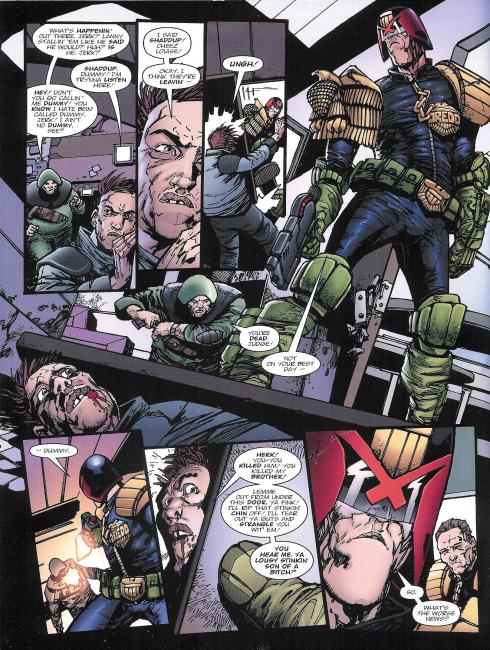
7) Prog 2012 – Choose Your Own Xmas: Script: Al Ewing, Art: John Higgins
The Xmas Dredd has always been a special case, a rare time the Prog affords Dredd more than 6 pages and fine tradition in linking to either festive citizen joviality or brooding winter reflection. This time Ewing made each panel a ‘Fighting Fantasy’ style chapter and readers could role-play being gormless lab tech Jackson Packard as he ventures into the unforgiving Mega-malls in search of finding X-mas presents and avoiding Christmas Day in the Iso-cubes. An ambitious exercise in subverting the unique nature of sequential panels and with wonderful goofy Cam Kennedy-alike citizenry from John Higgins Choose made for a very different, ambitious and, most importantly, hugely fun tale to add to the 2000AD banks. If ever Diceman gets a revival Ewing probably has a few drafts mapped out already.

6) Prog 1798-99 – Innocent: Script: Rob Williams, Art: Lawrence Campbell
Rob William’s Innocence is both a fantastic read and a great missed opportunity due to the savvy and style with which it dangled a concept, a drug making citizens incapable of crime, and swiped it away. The tale side-stepped tackling that fascinating issue, despite setting Dredd’s objections to it front and centre in the set-up, to switch into a ‘who-dunnit’ as the Judge advocating the measure is slain after a show-down with Joe. The art from returning driod Lawrence Campbell and coloured atmospherically by Chris Blythe helps lift an already well written tale into the best of the year. Campbell’s use of shadows and Blythe’s use of harsh lighting emphasise that MC-1 is broken and what light there is is glaring and artificial. Evoking past tales of attempts to chemically pacify citizens (Oz) and Dredd’s reflections on the influence of his Apocalypse War actions on the Day of Chaos the tale flirts with something greater but eventually settles for being a straight forward murder mystery all too quickly resolved. Pairing the murder with the conduct of the drug’s trial and the dilemma’s of doping a population to such an extent could have made for a great multi-part story but alas we’ll never know.. unless William’s decides to ‘rediscover’ the missing formula for the drug. If so, get Campbell and Blythe back on board and see what dark broken corridors of docility can be explored.
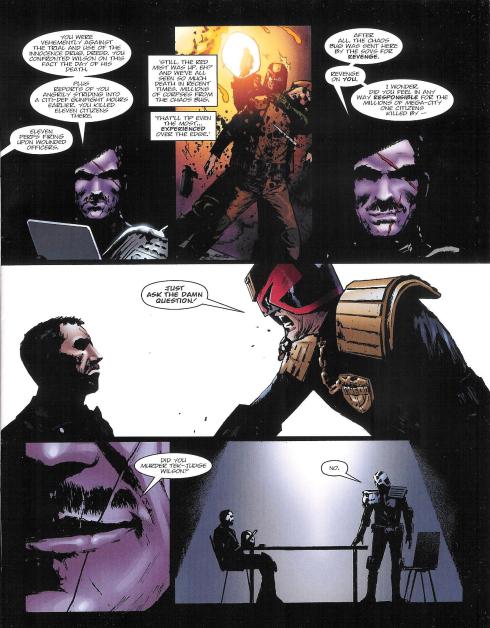
5) Prog 1774 – Day of Chaos: Eve of Destruction Pt 10: Script: John Wagner, Art: Ben Willsher
The remarkable Day of Chaos had already been through 29 episodes (or 32 including the PJ Maybe prologue) and was still the ‘day’ itself had not arrived but Prog 1774 marked the turn of the screw in brilliant fashion. For long-term readers the toppling of the Statute of Judgement (not for the first time but far more important since the role of PSU had been constantly increased) came as a blot from the blue, with the majority of the tale before concerning biological warfare. However the grand sweep of the Statute toppling is brilliantly counterpointed by the stomach turning lonely inglorious demise of one of MC-1’s ‘beautiful’ adversaries. Having slinked her way into MC-1 as rich-man’s plaything, then danced infection in skimpy attire the beautiful Titiana dies alone, decomposing and pecked at by a pigeon destined to spread her deathwish further. Willsher’s art is mercilessly intense as he depicts her leg breaking in a high impact fall and then the once beautiful body rotted like the fate of MC-1. A brilliant page of art, a brutal passage of Wagner prose and six pages that show the scales of death, large and small.
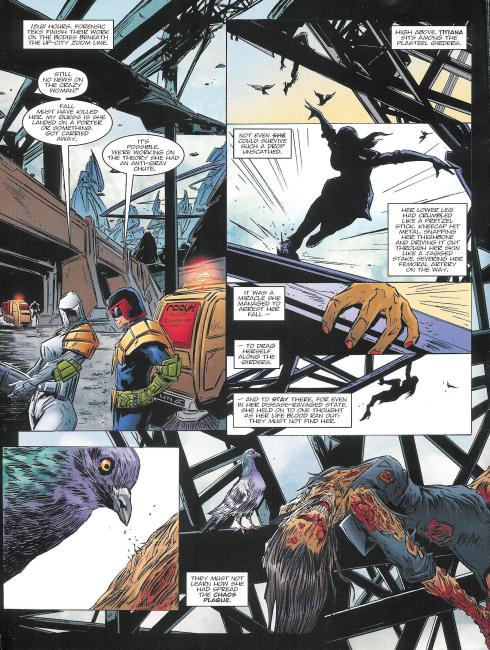
4) Meg 325-327 – Great Executions: Script Robbie Morrison, Art Dave Taylor
Outside of The Day of Chaos / Trifecta one Dredd story towered head and shoulders about the rest, that was the Dickensian riffing, heart crushing sadness of the tale of reluctant hitman Charlie Wackett in Great Executions. Wackett’s unwanted assignment to kill the woman he loves, and the betrayal of those few close to him, made for a compelling story with the years most beautiful art drawn by the peerless Dave Taylor. Morrison easily matches the language of Dickens with the vocabulary of MC-1 and keeps Dredd to a effective background role until his low-key contributions to the tale’s conclusion. The final panel deserves to be added to the pantheon of the very very best of Dredd. Prog-only readers should seek out these three Meg’s and see what a modern classic they missed.
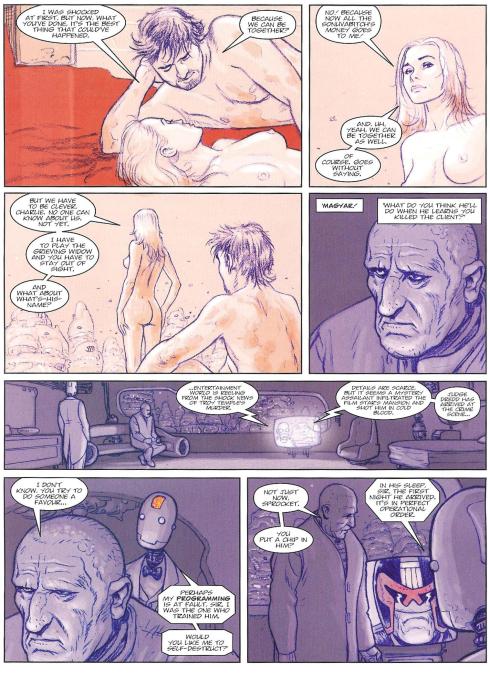
3) Prog 1812 – Trifecta: Script: Al Ewing, Si Spurrier, Rob Williams, Art: Carl Critchlow.
Trifecta was HUGE. Huge in all sorts of ways. A single story prog, a rare multi-author script collaboration, a finale to three existing major series arcs of very different Dredd-world stories and, seemingly, a massive publicity bonus for the House of Tharg. As a story it deserves applause on all sorts of levels, most notably the retention of the distinct voices of the different characters within the concluding tale. Returning, and all too-long absent, artist Carl Critchlow nails each character and maintains the depth of personality imbued by their regular weekly artists. A real risk of switching away from artists as distinct as D’israeli and Coleby would have been to have disengaged the audience but Critchlow and the power of the tale sweep the characters out of their respective strips and into this cross-over conclusion. Whether the deus ex machina of Judge Smiley is convincing or not remains another matter but in 28 pages Trifecta has more good lines, more whip and zing and more than enough success to pass over whether Smiley has really been able to evade and supervise through all the disasters since Judge Cal. The one shame of the tale is the all-too soon exposure of Bachmann who had far more potential than to be introduced and disposed of in 18 months (see last years praise of Ewing’s establishing strip The Family Man). The Simping Detective and Lowlife would have made it into this years non-Dredd top list were it not for Trifecta, Ewing’s Bachmann machinations (Prog 1803’s Bullet to King Four) likewise for this list. Together there can be no doubting the impact and success they had on Dredd in 2012. Trifecta was tri’riffica.
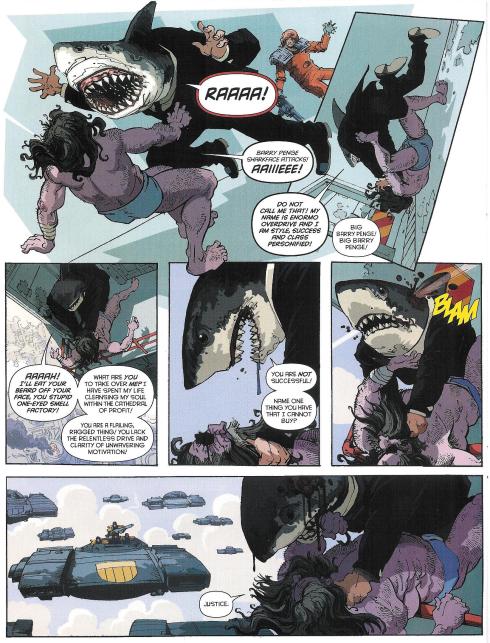
2) Prog 180 – The Cold Deck Pt 2 (Script: Al Ewing, Art: Henry Flint) / The Simping Detective: Jokers to the Right Pt 4 (Script: Si Spurrier / Art: Simon Coleby)
You have to feel a tad sorry for Lowlife‘s Rob Williams and D’israeli. Dirty Frank is in so many ways the heart of readers affections for Justice Department. He’s long since become a prog favourite, gets many great lines in Trifecta and is the constant hero throughout the story yet still it fell not to his tale of moon-side machinations with which to finally reveal to readers that Ewing, Spurrier and Williams had been playing a cold deck on us all. Ewing audaciously flags it up in his very first line (Prog 1806’s victim staring directly at the reader and asking ‘you know what a cold deck is‘) and yet is there anyone who can creditably say that, until the first panel of The Simping Detective carried on from the final panel of Dredd, they saw what was coming? Not here. Not in this household. Nuh-huh. Futureshockd ain’t ever going to be playing Ewing, Williams or Spurrier at poker. Of course a few pages on and Dirty Frank gets in on the act by receiving the message that the Simping Detective sent that Dredd tried to stop but… well by then it was out. We’d been duped, long-conned, played, dumped on our butts like chumps and our mouths open in amazement. Poor Dirty Frank. Late to the party as ever. Even more so than the excellent conclusion (Trifecta) Prog 1807’s ‘moment’ will remain one of ‘those’ 2000AD things people will discuss years from now. Do you know what a Cold Deck is? You do now.

1) Prog 1788 – Chaos Day, Part 2: Script John Wagner, Art Henry Flint
This is the way the world ends
This is the way the world ends
This is the way the world ends
Not with a bang but a whimper
In Chaos Day Part 2 the city whimpered. In Chaos Day Part 2 Judge Dredd, the Judge Dredd (as the movie’s Judge Lex so admirably snarled) whimpered. Chaos Day ended just as it started. It ended because there was nothing left but fall. No redemption. No saving. Nothing but a whimper and the city father, John Wagner, laying out the dictum: ‘This city is dying before his eyes‘. The end of the Day of Chaos wrong-footed so many who assumed that the long-running ‘Nadia‘ and ‘Eve of Destruction‘ were mere preludes rather than the ‘mega-epic’ itself. But by the time the Day of Chaos arrived so much had been torn down, the vestiges of power and authority so dismantled that there was no force left to save the day. There is rot and containment. Small stories and despair. Wagner’s tale is post-hollywood, post-post-Watchmen, not everything needs to have significance, not everything needs to be foreshadowing, some things become important, some wither and die. PJ Maybe wasn’t relevant, the Dark Judges just fizzled out, the villains died by their own actions not those of heroes. Are there even any heroes? The Day of Chaos was messy, a bombardment of varying successes and failures for the characters, a scramble for survival and at the end the answer is did the city survive? Maybe not. 2013 should be the year writers sit down and really reflect on what Wagner has done to his plaything. This isn’t just another ‘carry on with what’s left’, not another post-Necropolis, Post-Apoclaypse War. Or it shouldn’t be. Sit down with all 50 issues and applaud the greatest Dredd tale yet.
